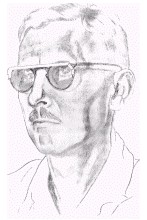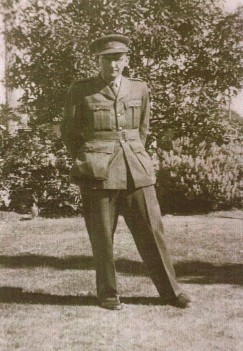 |
 |
![]()
| Captain Theodore (Tim) Godlee Wx11057 |
| Regimental Medical Officer 2/3 Machine Gun Battalion |
 |
Tim Godlee was born in Adelaide in 1906. Following completion of his medical studies at Adelaide University, he completed his postgraduate training at Royal Perth Hospital in Western Australia. He married Cynthia Dunman in 1933 and went into General Practice in Northampton. They had two sons, John in 1934 and Rick in 1937. He enlisted on 25 April 1941 (Anzac Day) and initially was posted 2/3/4 Reinforcement 2/13 Field Ambulance. Whilst in the Middle East he became the Regimental Medical Officer to the 2/3 Machine Gun Battalion. (He replaced Captain Dick Pellew as RMO). “Tim Godlee soon established himself as a competent RMO as well as acquiring a reputation for the successful diagnosis of malingering”. “He (Captain Godlee) had quickly won the Battalion’s respect.” - From Snow to Jungle. |
He was with 2/3 Machine Gun Battalion in Java and in March 1942 became a POW. In January 1943 Dunlop Force left Java for Thailand (en route in Singapore 7 January to 20 January 1943). Dunlop Force comprised around 900 POWs and included four Medical Officers, Lt Col Dunlop, Major Moon, Major Corlette and Captain Godlee together with one Dental Officer Major Jock Clarke and two highly competent Regular officers Major Bill Wearne and Major Allan Woods. On arrival in Thailand Dunlop Force was deployed near the area now known as Hellfire Pass. The Medical Officers were deployed at Hintok Mountain, Hintok River and Konyu Camps.
“Tim Godlee, has opened a new tented hospital of his own and runs it very well…….” – War Diaries of Weary Dunlop (March 43) p207.
In March 1943 Capt Godlee was sent up to Kinsayok and was forced to do manual labour in addition to his responsibilities as a Medical Officer. He seems to have been at Kinsayok (a large camp for around 5,000 POWs) for around a year. He was then moved south to Tamuan where he had the unenviable task of being involved in selecting POWs for the Japan Party. Later in 1944 when at Nakom Pathon Tim was sent back up the line with a maintenance party and was located near Konkoita. It was here that he had to perform operations on two POWs with perforated ulcers (one of the oesophagus). It is incredible, in these conditions, that even one of these patients survived.
Tim was discharged from active service in January 1946 and was placed on the Reserve of Officers (AAMC).
In 1945 an article appeared in the West Australian Newspaper where Lieutenant Colonel Ted Lyneham (CO 2/3 Machine Gun Battalion) specifically mentioned “Captain Godlee had the care of 1,000 Australians in an isolated camp on Java and fought the Japanese with sheer determination…”
In 1947 Tim Godlee was appointed a Member of The Order of the British Empire, for meritorious service as POW in Java and Thailand. The citation for his MBE reads, “Captain Godlee saved many lives in a Prison Camp in Java despite shortness of drugs and lack of assistance. Subsequently, from 1943 to the end of hostilities, the low rate of mortality in remote jungle camps in Thailand was a supreme tribute to his skill”. His insignia was presented at Government House, Perth in May 1950. At the time of this presentation his address was shown as Big Bell.
Post war Tim had established a general practice centred in the mining town of Big Bell (in the interior of Western Australia). The practice extended over a huge area, from Mount Magnet in the south to Reedy (then a mining town) to the north. The practice also included the town of Cue and many outlying stations. Subsequently, he moved to Mount Magnet. His wife Cynthia became unwell and he moved to Perth to work in the Repatriation Department. In 1951 Cynthia passed away. In 1953 Tim remarried and took up a posting as Medical Officer on Cocos Island. He was there for a couple of years and was presented to the Queen when she visited the island on her maiden visit to Australia. Returning to Australia he occupied the following positions in the Repatriation Department - Senior Medical Officer (SMO) Hobart, Deputy SMO Sydney, SMO Brisbane and finally SMO Adelaide. Amongst other health problems he developed cancer of the tongue. He took early retirement and died of liver cancer on 5 September 1976.
Notes prepared by Lieutenant Colonel Peter Winstanley OAM RFD
(Ret’d) JP October 2003.
(E-mail peterwinstanley@bigpond.com
). Notes revised following contact with Tim Godlees’ sons John &
Rick June 2005.
Caption with sketch “With fond memories of Dr Tim
Godlee, gentlemen and scholar, in trying conditions on the Burma Siam
Railway. He upheld the finest medical traditions”
Compliments of the artist J.S. (Jim) Collins Corporal NX65538 HQ 22 Brigade.

The above picture was taken after enlistment.
“YOU’LL BE RIGHT”
(Dedicated to Dr. Tim Godlee)
A lean ex-army croaker,
Was sitting on his date,
A’polishing his dimmers,
And brooding o’er his fate.
Along had come that morning,
A wealthy socialite,
To bend his ear a little,
About her body’s plight.
She liked to drop in often,
And pitch her tale of woe,
To talk of her insomnia,
Her problems down below.
Her dizzy spells and headaches,
Her ever achin’ back,
She really laid it on him,
This hypochondriac.
She liked to have him sound her,
And gravely shake his head,
To have him tell her sadly,
“You ought to be in bed.”
She was indeed a trial,
But welcome just the same,
A goodly source of income,
This very wealthy dame.
And better thus to suffer,
For most rewarding fee,
Than fixing bloody inmates,
In Burma, all for free.
But curse that bloody railway,
He’d lost her now for good,
He’d said from force of habit,
“Oh you’ll be right” – he would!
By Jim Collins, NX65538
|
|